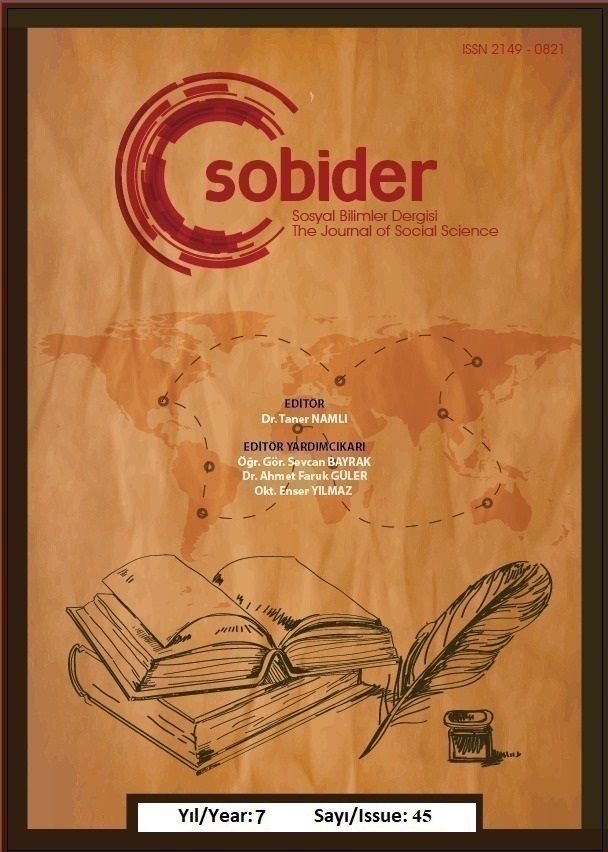Author :
Abstract
Bu çalışmada Fransızca kelimelerden oluşmuş Türkçe birleşik isimler ele alınmaktadır. Bunun için Türkçede Batı Kökenli Kelimeler Sözlüğü esas alınarak konuyla ilgili örnekler yazılıp Türkçedeki anlamları verilmiştir. Daha sonra birleşiği oluşturan kelimelerin kaynak dildeki, yani Fransızcadaki anlamları tek tek açıklanmıştır. Birleşik isim hükmünde olan birleşik kelimelerin isim tamlaması, sıfat tamlaması, edat grubu, zarf grubu, hâl ekli isimlerle oluşturulmuş isim grubu, çekimli fiil ya da ikileme kalıbında olabildikleri bilinmektedir. Bundan hareketle söz konusu birleşik kelimelerin hangi türdeki bir yapıyla oluşturulduklarının gösterilmesi hedeflenmiştir. Sonuç olarak isim tamlaması ya da sıfat tamlaması kalıbında kuruldukları gözlenen bu birleşikler, isim tamlaması ya da sıfat tamlaması kalıbında olmalarına göre ikiye ayrılarak incelenmiş, ayrıca Türkçede ve Fransızcada isim tamlaması ve sıfat tamlaması kalıplarının nasıl kurulduğuna değinilmiştir. Sıfat tamlaması kalıbındaki Fransızca kelimelerden oluşmuş Türkçe birleşik isimlerin isim tamlaması kalıbındakilere oranla sayıca çok daha fazla olduğu anlaşılmıştır.
Keywords
Abstract
This study examines Turkish compound nouns that are made up of French words. To this end, based on Türkçede Batı Kökenli Kelimeler Sözlüğü, related examples are written and their significances in Turkish are provided. Next, the meanings of the words forming the compound in the source language, namely French, are explained one by one. It is known that compound words, which are considered compound nouns, can be in the form of possessive construction, adjective clause, postposition group, adverb group, noun groups that are made up of cases, finite verb or reduplication. Starting from this point, it is aimed to show what kind of structure these compound words are formed with. As a result, these compounds, which are observed to be formed in the possessive construction or adjective clause pattern, are divided into two according to whether they are in the possessive construction or adjective clause pattern. Moreover, how the possessive construction and adjective clause are established in Turkish and French is mentioned. It has been understood that Turkish compound nouns composed of French words in the adjective clause pattern are higher in number than those in the possessive construction structure.
Keywords
- Çiçek, Mehmet, (2013), “Fransızcada Ad-Sıfat İlişkisi ve Türkçeye Çevirisi”, Turkish Studies, Volume 8/10, s. 221-232.
- Eker, Süer, (2005), Çağdaş Türk Dili, Grafiker Yayınları, Ankara.
- Ergin, Muharrem, (2002), Türk Dil Bilgisi, Bayrak Yayınları, İstanbul.
- Korkmaz, Zeynep, (1992), Gramer Terimleri Sözlüğü, Türk Dil Kurumu Yayınları, Ankara.
- Özkan, Mustafa, (1996), “Yapılış, Yazılış ve Kullanılışları Bakımından Birleşik Kelimeler”, İlmi Araştırmalar, 2, s. 95-110.
- Saraç, Tahsin, (2003), Büyük Fransızca-Türkçe Sözlük / Grand Dictionnaire Français-Turc, Adam Yayınları, İstanbul.
- Türkçe Sözlük, (2011), Türk Dil Kurumu Yayınları, Ankara.
- Türkçede Batı Kökenli Kelimeler Sözlüğü, (2015), Türk Dil Kurumu Yayınları, Ankara.





